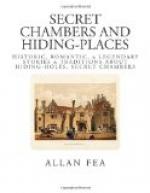It is well known that the huge, carved oak bedsteads of the sixteenth and seventeenth centuries were often provided with secret accommodation for valuables. One particular instance we can call to mind of a hidden cupboard at the base of the bedpost which contained a short rapier. But of these small hiding-places we shall speak presently. It is with the head of the bed we have now to do, as it was sometimes used as an opening into the wall at the back. Occasionally, in old houses, unmeaning gaps and spaces are met with in the upper rooms midway between floor and ceiling, which possibly at one time were used as bed-head hiding-places. Shipton Court, Oxon, and Hill Hall, Essex, may be given as examples. Dunster Castle, Somersetshire, also, has at the back of a bedstead in one of the rooms a long, narrow place of concealment, extending the width of the apartment, and provided with a stone seat.
Sir Ralph Verney, while in exile in France in 1645, wrote to his brother at Claydon House, Buckinghamshire, concerning “the odd things in the room my mother kept herself—the iron chest in the little room between her bed’s-head and the back stairs.” This old seat of the Verneys had another secret chamber in the middle storey, entered through a trap-door in “the muniment-room” at the top of the house. Here also was a small private staircase in the wall, possibly the “back stairs” mentioned in Sir Ralph’s letters.[1]
[Footnote 1: See Memoirs of the Verney Family.]
[Illustration: SHIPTON COURT, OXFORDSHIRE]
[Illustration: BROUGHTON CASTLE, OXFORDSHIRE]
Before the breaking out of the Civil War, Hampden, Pym, Lord Brooke, and other of the Parliamentary leaders, held secret meetings at Broughton Castle, oxon, the seat of Lord Saye and Sele, to organise a resistance to the arbitrary measures of the king. In this beautiful old fortified and moated mansion the secret stairs may yet be seen that led up to the little isolated chamber, with massive casemated walls for the exclusion of sound. Anthony Wood, alluding to the secret councils, says: “Several years before the Civil War began, Lord Saye, being looked upon as the godfather of that party, had meetings of them in his house at Broughton, where was a room and passage thereunto which his servants were prohibited to come near."[1] There is also a hiding-hole behind a window shutter in the wall of a corridor, with an air-hole ingeniously devised in the masonry.
[Footnote 1: Memorials of Hampden.]
The old dower-house of Fawsley, not many miles to the north-east of Broughton, in the adjoining county of Northamptonshire, had a secret room over the hall, where a private press was kept for the purpose of printing political tracts at this time, when the country was working up into a state of turmoil.
When the regicides were being hunted out in the early part of Charles II.’s reign, Judge Mayne[1] secreted himself at his house, Dinton Hall, Bucks, but eventually gave himself up. The hiding-hole at Dinton was beneath the staircase, and accessible by removing three of the steps. A narrow passage which led from it to a space behind the beams of the roof had its sides or walls thickly lined with cloth, so as to muffle all sound.




